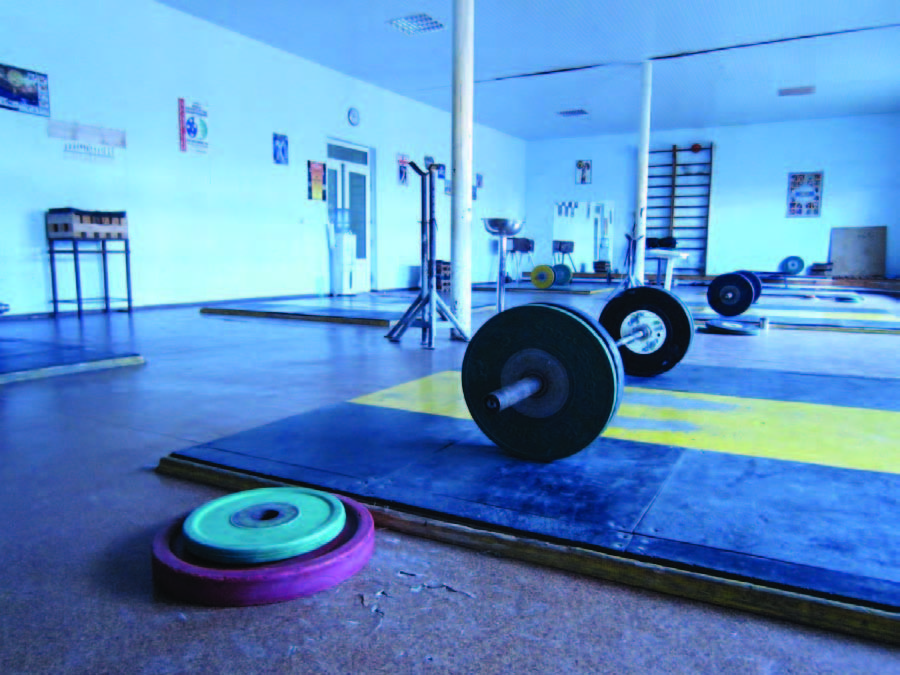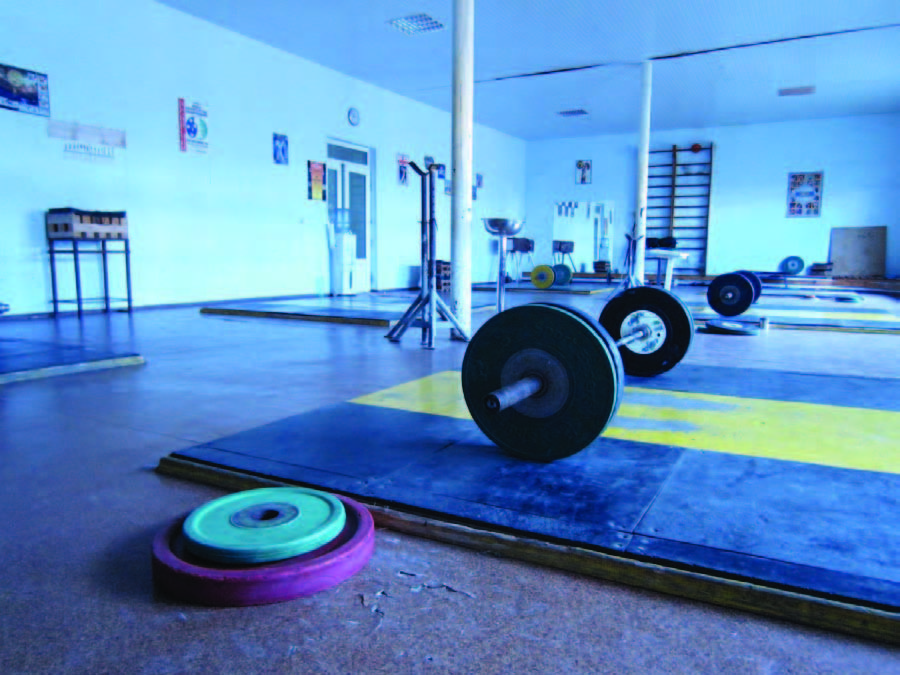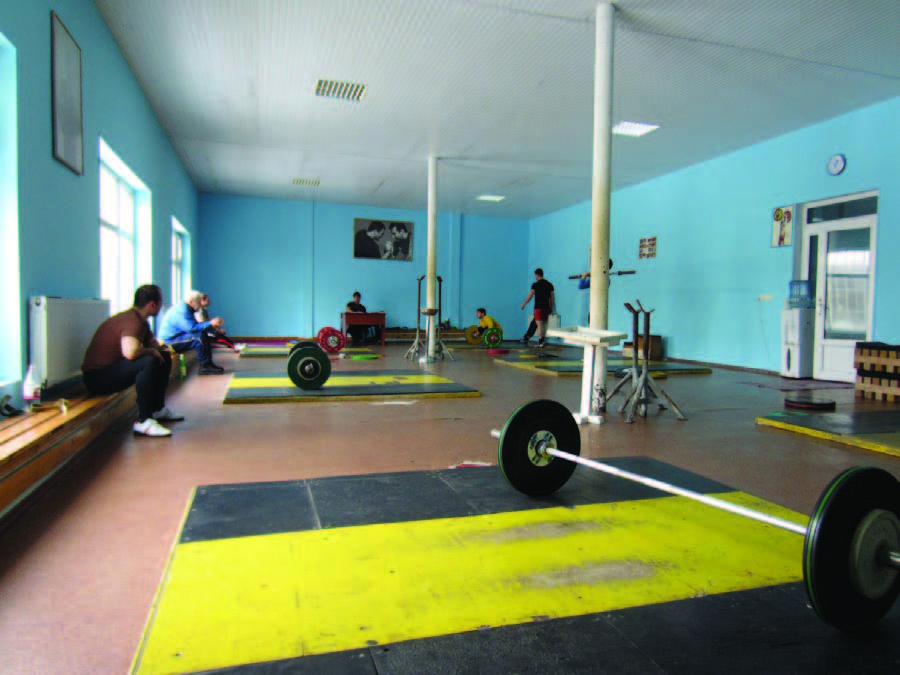A Glimpse into the National Weightlifting Federation of Georgia

Georgia is a small country located next to the Black Sea. Tbilisi is its capital. Presently the population of Tbilisi is between 1 and 1.5 million people, depending on how the outskirts are counted. The population of Georgia itself is somewhere around 4.5 million. Most have heard of Georgia because of the war with Russia that made headlines in 2008. Georgia also has a reputation for its extravagant hospitality, mountainous landscapes, mineral waters, folk dancing and polyphonic singing. In addition, it may have been the birthplace of wine.
In September 2011, I came to Tbilisi for a year to work on my dissertation research in linguistic anthropology. I study the Georgian language, and particularly how it has been influenced by Russian. One can only suffer through complex agglutinative verb morphology for so many hours a day, so I began to look for a place to train to ward off muscle atrophy and generalized despair. As usual, most of the addresses and phone numbers listed online simply didn't exist. By contacting the Ministry of Sport, I set up a meeting at a gym located near the training facilities for swimming, fencing, wrestling and tennis. This turned out to be the National Weightlifting Federation of Georgia.
I found the gym after walking through a series of alleys, past homeless sleeping dogs, haphazardly parked Volgas and BMWs, and down a tiny staircase next to a soccer field. I sat down in the office at the gym and explained that I was looking for a place to train for the year. After a short conversation, they told me that I was welcome to train there. The first day I blew my cool by accidently falling off of the glute ham raise/back extension set-up.
Some combination of generosity and pity for my weak legs and woeful technique compelled the trainers to start giving me advice. I began to train the Olympic lifts exclusively. Early on, one of the coaches, Temur, explained that my main problem was that I was physically weak. Hard to argue with that one. I continued showing up four times a week, so after a few months I've been more or less accepted, and have even participated in a weightlifting competition here.
The main room of the gym has six platforms. There is a second smaller room with a few other platforms, as well as a ping-pong table. During training, coaches sit on the long wooden bench in front of the windows and yell technique cues at the weightlifters, and also instruct them on what weights to use, and for how many more sets.
The athletes at GEOWF are mostly teenagers, though there are also younger kids here, including a group of 11 and 12 year olds who they often refer to as the "crazies" (gizhebi). The international-level competitors train at another facility outside of town. The teenagers at GEOWF train 6 days a week, with Sundays off. Training sessions typically last around 2-3 hours a day, alternating between "big" training days and "small" training days. Some have been training there for years, and others have started relatively recently. It is difficult to generalize about what is done to develop weightlifters at GEOWF, since it varies by experience level and technical/strength needs. Nevertheless, a common feature of training is that exercises are performed in high volume (accrued over multiple sets), rather than singles.
A typical Wednesday, for example, might start with a snatch variation performed for 3 x 3 at each weight, ultimately leading to a "training" weight for the day. Then cleans, also done for 3 x 3, building up to a "training" weight for the day. Next, clean pulls, done for 4 sets of 4, and finally front squats for 3 x 3. For all of these exercises (with the exception of clean pulls), lower weights are also done for multiple sets. Afterwards, it is not uncommon for lifters to do back extensions, ab training, technique work with an empty bar, wrist curls, light presses, lateral raises or other movements.

I thought it would be best to let one of the trainers describe aspects of the training. The following short interview was conducted in Georgian:
Is there a "Georgian" method of training that is different from the approaches in Russia, Bulgaria, or other countries well known for success in Olympic weightlifting?
Temur Janjgava (TJ): Weightlifting as a sport was introduced in Georgia in the 1930s. Weightlifting was better developed in the former Soviet Union (1885); the methodology was basically Russian, and we follow the same methodology to date. There is a Bulgarian methodology as well, which many countries follow, though lifting too much weight on a daily basis causes frequent injuries.
I have heard that people from the villages in Georgia are stronger than people from the city. Do you think this is true?
TJ: As far as selection is concerned, children from provincial (rural) areas adapt to weightlifting exercises easier, since they help their parents in physical work from early childhood. Almost all children swim in the river (if there is a river around). In the mountainous regions, children go to the mountains regularly, so their muscular system is better developed and they are stronger and more flexible. The fact that they are accustomed to physical work makes training easier for them.
Which Georgian weightlifters will be competing in the London 2012 Olympics?
TJ: The National Weightlifting Federation of Georgia has three licenses for the London summer Olympics. One member undoubtedly will be Gia Machavariani (105 kg), who has a good chance to fight for an Olympic medal. The other two members will be known once the Georgian championship has been held (May 18-21).
How are lifters selected and developed for the national team?
TJ: National team members are selected according to the results they have shown during competition. Besides, major factors are considered such as a sportsman’s health, his technical condition, and clear indication of a strong will.
When training the younger kids (11and 12 years old), what do you all look for? What is most important?
TJ: As far as younger kids are concerned, it should be mentioned that the beginners’ age has been decreasing lately, therefore the first phase of their training includes general training, learning techniques and improving physical skills (speed, strength, flexibility, endurance).

Can you provide a sample program for how lifters at GEOWF train? For example, a general picture of how a lifter's training for one week would be– which lifts usually happen on which days, what percentages are used, and so on. We understand that all of this is subject to change based on what the coach sees, and how close it is to competition.
TJ: The National Weightlifting Federation of Georgia is responsible for developing weightlifting and achieving success. The main accent is made on selected teams (age - men, juniors, youngsters), since they are the major candidates for medals. As far as the training methodology is concerned, every coach has his own style, but the basic framework remains as described in the first question.
Selecting different weights is individual, but the main exercises are performed with 70-80% weights. Maximum weights are lifted once in two weeks, in the way of so-called control trial, on the basis of which the coach makes corrections.
Training: 2 times - Monday, Wednesday, Friday
1 time - Tuesday, Thursday, Saturday.
The main goal is that the sportsman should be in the best shape during the planned competition and achieve the maximum result.
Thanks to Temur Janjgava, Gela Makharashvili, Guram Parulava, Aleko Nozadze, Avtandil Gakhokidze and Ramaz Gurgenidze.
In September 2011, I came to Tbilisi for a year to work on my dissertation research in linguistic anthropology. I study the Georgian language, and particularly how it has been influenced by Russian. One can only suffer through complex agglutinative verb morphology for so many hours a day, so I began to look for a place to train to ward off muscle atrophy and generalized despair. As usual, most of the addresses and phone numbers listed online simply didn't exist. By contacting the Ministry of Sport, I set up a meeting at a gym located near the training facilities for swimming, fencing, wrestling and tennis. This turned out to be the National Weightlifting Federation of Georgia.
I found the gym after walking through a series of alleys, past homeless sleeping dogs, haphazardly parked Volgas and BMWs, and down a tiny staircase next to a soccer field. I sat down in the office at the gym and explained that I was looking for a place to train for the year. After a short conversation, they told me that I was welcome to train there. The first day I blew my cool by accidently falling off of the glute ham raise/back extension set-up.
Some combination of generosity and pity for my weak legs and woeful technique compelled the trainers to start giving me advice. I began to train the Olympic lifts exclusively. Early on, one of the coaches, Temur, explained that my main problem was that I was physically weak. Hard to argue with that one. I continued showing up four times a week, so after a few months I've been more or less accepted, and have even participated in a weightlifting competition here.
The main room of the gym has six platforms. There is a second smaller room with a few other platforms, as well as a ping-pong table. During training, coaches sit on the long wooden bench in front of the windows and yell technique cues at the weightlifters, and also instruct them on what weights to use, and for how many more sets.
The athletes at GEOWF are mostly teenagers, though there are also younger kids here, including a group of 11 and 12 year olds who they often refer to as the "crazies" (gizhebi). The international-level competitors train at another facility outside of town. The teenagers at GEOWF train 6 days a week, with Sundays off. Training sessions typically last around 2-3 hours a day, alternating between "big" training days and "small" training days. Some have been training there for years, and others have started relatively recently. It is difficult to generalize about what is done to develop weightlifters at GEOWF, since it varies by experience level and technical/strength needs. Nevertheless, a common feature of training is that exercises are performed in high volume (accrued over multiple sets), rather than singles.
A typical Wednesday, for example, might start with a snatch variation performed for 3 x 3 at each weight, ultimately leading to a "training" weight for the day. Then cleans, also done for 3 x 3, building up to a "training" weight for the day. Next, clean pulls, done for 4 sets of 4, and finally front squats for 3 x 3. For all of these exercises (with the exception of clean pulls), lower weights are also done for multiple sets. Afterwards, it is not uncommon for lifters to do back extensions, ab training, technique work with an empty bar, wrist curls, light presses, lateral raises or other movements.

I thought it would be best to let one of the trainers describe aspects of the training. The following short interview was conducted in Georgian:
Is there a "Georgian" method of training that is different from the approaches in Russia, Bulgaria, or other countries well known for success in Olympic weightlifting?
Temur Janjgava (TJ): Weightlifting as a sport was introduced in Georgia in the 1930s. Weightlifting was better developed in the former Soviet Union (1885); the methodology was basically Russian, and we follow the same methodology to date. There is a Bulgarian methodology as well, which many countries follow, though lifting too much weight on a daily basis causes frequent injuries.
I have heard that people from the villages in Georgia are stronger than people from the city. Do you think this is true?
TJ: As far as selection is concerned, children from provincial (rural) areas adapt to weightlifting exercises easier, since they help their parents in physical work from early childhood. Almost all children swim in the river (if there is a river around). In the mountainous regions, children go to the mountains regularly, so their muscular system is better developed and they are stronger and more flexible. The fact that they are accustomed to physical work makes training easier for them.
Which Georgian weightlifters will be competing in the London 2012 Olympics?
TJ: The National Weightlifting Federation of Georgia has three licenses for the London summer Olympics. One member undoubtedly will be Gia Machavariani (105 kg), who has a good chance to fight for an Olympic medal. The other two members will be known once the Georgian championship has been held (May 18-21).
How are lifters selected and developed for the national team?
TJ: National team members are selected according to the results they have shown during competition. Besides, major factors are considered such as a sportsman’s health, his technical condition, and clear indication of a strong will.
When training the younger kids (11and 12 years old), what do you all look for? What is most important?
TJ: As far as younger kids are concerned, it should be mentioned that the beginners’ age has been decreasing lately, therefore the first phase of their training includes general training, learning techniques and improving physical skills (speed, strength, flexibility, endurance).

Can you provide a sample program for how lifters at GEOWF train? For example, a general picture of how a lifter's training for one week would be– which lifts usually happen on which days, what percentages are used, and so on. We understand that all of this is subject to change based on what the coach sees, and how close it is to competition.
TJ: The National Weightlifting Federation of Georgia is responsible for developing weightlifting and achieving success. The main accent is made on selected teams (age - men, juniors, youngsters), since they are the major candidates for medals. As far as the training methodology is concerned, every coach has his own style, but the basic framework remains as described in the first question.
Selecting different weights is individual, but the main exercises are performed with 70-80% weights. Maximum weights are lifted once in two weeks, in the way of so-called control trial, on the basis of which the coach makes corrections.
Training: 2 times - Monday, Wednesday, Friday
1 time - Tuesday, Thursday, Saturday.
The main goal is that the sportsman should be in the best shape during the planned competition and achieve the maximum result.
Thanks to Temur Janjgava, Gela Makharashvili, Guram Parulava, Aleko Nozadze, Avtandil Gakhokidze and Ramaz Gurgenidze.
|
Perry Sherouse is a Ph.D. student in Linguistic Anthropology at the University of Michigan. He is currently living in Tbilisi, Georgia. |
Search Articles
Article Categories
Sort by Author
Sort by Issue & Date
Article Categories
Sort by Author
Sort by Issue & Date

